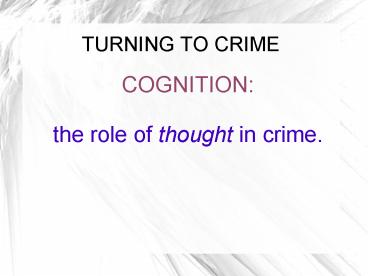TURNING TO CRIME - PowerPoint PPT Presentation
1 / 21
Title:
TURNING TO CRIME
Description:
TURNING TO CRIME COGNITION: the role of thought in crime. Determinism vs Free Will Can you help what you do? Do you have your own mind? Is your fate pre-determined? – PowerPoint PPT presentation
Number of Views:61
Avg rating:3.0/5.0
Title: TURNING TO CRIME
1
TURNING TO CRIME
- COGNITION
- the role of thought in crime.
2
Determinism vs Free Will
- Can you help what you do?
- Do you have your own mind?
- Is your fate pre-determined?
- Can criminality be outside your control?
3
Some good films to watch to see criminal thinking
patterns in action
- Goodfellas
- The Godfather
- This is England
- The Departed
4
Criminal thinking patterns
- Tell me if any of these acts are okay
- 1 Mugging an old lady.
- 2 Stealing a car.
- 3 Killing your spouse in a jealous rage.
- 4 Shoplifting an item under 10 in value.
- 5 Giving a false address in order to get your
child into the school of your choice. - 6 Killing at least 13 women because the voices in
your head told you to do so.
5
Bad? Or mad?
- Actus reus the act of committing a crime (ie
you are definitely guilty of the action involved
in the crime). - Mens rea the 'free will' element of the crime
(ie did you realise what you were doing, were you
responsible for your actions?)
6
Diminished responsibility
- What's your understanding of this legal term?
7
Peter Sutcliffe and mens rea
- http//www.youtube.com/watch?v8niHc4bB9Bsfeature
playerembedded
8
Diminished responsibility
- Homicide act (1957)
- When an individual is suffering from an
abnormality of mind which substantially impairs
the responsibility of acts or omissions. - can include extreme anger, emotional imbalance,
intoxication as well as mental illness. - Defence must prove a defect of reason at time of
the offence.
9
Criminal thinking patterns.
- Focus of this topic
- - do criminals think differently to
non-criminals? - - can criminal thinking patterns be changed?
- - by changing thinking patterns can you prevent
crime?
10
KEY STUDY
- Yochelson Samenow,
- A study of thinking patterns in criminals.
11
Pp15-16 in textbook.
- Y S have been working in this field cognition
and criminality for over 30 years. They are very
interested in how criminals rationalise their
crimes.
12
Before we look at our key study, some
background...
- Their work is longitudnal so has many date
references for separate findings. - 1976 240 male offenders interviewed.
- YS found that
- criminals slightly less intelligent than non-c
- in control of lives, crimes result of choice
- distorted self-image denial of own role in
crimes no sense of responsibility 40 'thinking
errors.
13
Key Study
- Participants 255 male offenders, mixed
demographic roughly half deemed insane (confined
to secure hospital) and half 'normal' (prison).
All had been found guilty of their crimes. - No control group of non-c's.
14
Aims of study
- 1 To understand the criminal personality.
- 2 To develop ways of treating personality
disorders. - 3 To encourage c's to understand legal
responsibility. - 4 To develop ways of preventing criminal
behaviour.
15
Method
- Interviews conducted over a period of several
years. - So quantitative or qualitiative data collected?
- Advantages/disadvantages of this method?
16
Huge catalogue of findings.
- Here are some
- restlessness, dissatisfaction, irritability of
c's - want excitement
- lack empathy
- are highly self-interested and disregard any
rules/laws which compromise this - jump to conclusions and judge poorly
- BUT...they are already in prison, which suggests
what about them?
17
Yes, that's right...
- As the interviewees were already in prison they
clearly are - a) already in a criminal 'mindset' which may have
been exagerrated by being incarcerated. - b) they are not very good at eluding capture (ie
smarter criminals have higher IQ but not in study
cos not captured!) - c) they are used to lying/deceit.
- d) most people in prison are liable to feel
'restless and dissatisfied'. - e) we don't know what their thinking patterns
were prior to incarceration.
18
Did the interviews rehabilitate the c's?
- In a word, no.
- Only 30 made it through to end of study. 9 had
genuinely changed the way they thought. - Techniques used included Freudian psychotherapy
why do you think YS used this?
19
Problem
- YS had originally wanted to find cause of crim
beh. - In interviews lots of c's lied (big surprise) and
gave the answers they thought would help their
situation. - So...YS looked at their thinking patterns
instead, as this was easier to analyse.
20
Thinking errors
- YS now had 52 thinking errors that defined
criminal thinking patterns. - Non-c's also make these errors but c's make more
of them more often. - But...no non-c control group so hard to know
extent of this. - Research evolved out of clinical practice, not
originally intended as a separate study.
21
HOMEWORK
- Write one paragraph on each of the following
- Why might the public/victim's family object to
a diminished responsibility verdict in a
notorious murder case? - Why is the sample a problem in this study?
- Who would make the ideal control group in this
study?
























![[PDF] READ Free Moonshine Mafia: A Crime Caper Inspired by True Events PowerPoint PPT Presentation](https://s3.amazonaws.com/images.powershow.com/10050063.th0.jpg?_=202406070810)






